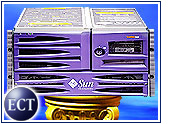
Amid harsh criticism from the competition, Sun Microsystems has introduced its first general-purpose Linux server.
The play marks a shift in Sun’s strategy, which was built on the company’s ability to deliver high-end servers running its own Solaris operating system.
Now, Sun has broadened its focus with the LX50, an entry-level server based on Intel’s x86 architecture. The relatively low-cost server is a two-processor machine that runs Linux, Solaris and the Java programming language.
Systems Approach
Sun executives said the LX50 also helps fill security and stability gaps using the company’s systems approach.
“Our enterprise customers asked us to apply our systems approach to entry servers,” said Neil Knox, Sun’s executive vice president of volume systems products.
“They wanted easy, rapid implementation and full systems support, without the current viruses, security issues and licensing headaches of Windows.”
Sun is positioning the new server as an alternative to the piecemeal software/hardware approach of other vendors.
While 32-bit applications are being deployed at the edge of networks, Knox said, no one is addressing the need to merge the benefits of open systems and low cost with easy deployment and management in an enterprise-class system.
Serving Customers
Forrester analyst Carl Howe told the E-Commerce Times that introducing the Linux server is a “fairly natural” move for Sun. He noted that the company has sold x86 boxes in the past, and that Linux is akin to Sun’s other product lines.
In addition, Howe said, Sun was faced with a choice: It could either offer a Linux server or lose low-end sales to other companies, namely Dell.
“Customers told Sun they wanted to buy Linux machines,” he noted. “With their arm twisted behind their backs, they decided to make the sales and cash the checks.”
Debating the Strategy
In short, while it is easy to take sides in the server market battle between tech industry titans like Sun and IBM — whose executives have been especially critical of the LX50 — market realities in tough economic times demand that vendors sell what customers want.
Some analysts have said this is a turning point for Sun that could backfire. Others think that early speculation about Linux clashing with Sun’s ONE architecture message is a little too far-fetched.
“At the end of the day, you have a choice between selling products or not,” Howe said. “Generally, I tend to favor giving customers what they want.”
Leaping Linux
While Sun is drawing criticism from its competitors and from some industry analysts, no one is questioning the Linux platform.
Sales of Linux-based servers are growing 15 to 20 percent every year, according to research firm IDC. And not all analysts think Sun’s LX50 launch is a bad move.
For example, IDC analyst John Humphreys said the LX50 opens “vast new opportunities” for Sun in the sub-US$10,000 server market.
“The positioning of the LX50 is just right for capturing some of that market share for Sun and to strengthen its offerings in the entry server segment,” Humphreys said.
The new server will sell for $2,795 with one 1.4 GHz CPU, 512 MB of RAMand a 36 GB SCSI hard drive. A system with two 1.4 GHz CPUs, 1 GB of RAM and a 72 GB SCSI hard drive sells for $4,295.
Executives at Microsoft, IBM and Dell could not immediately be reached for comment.












































Social Media
See all Social Media